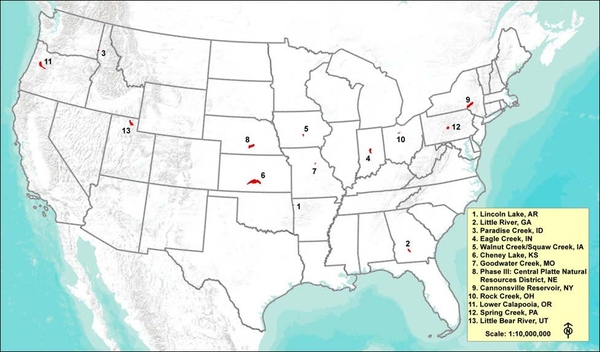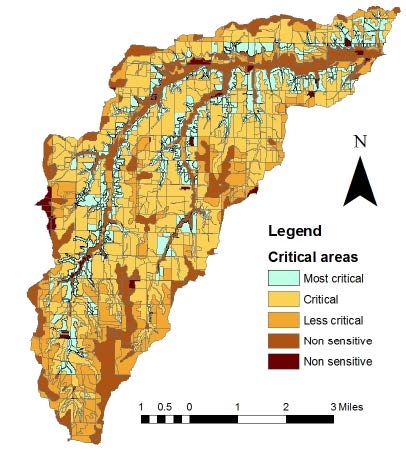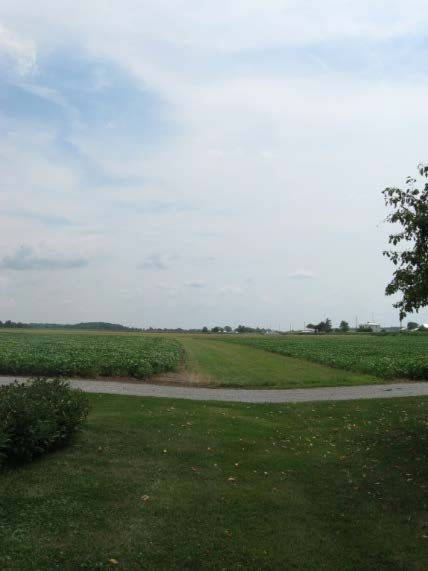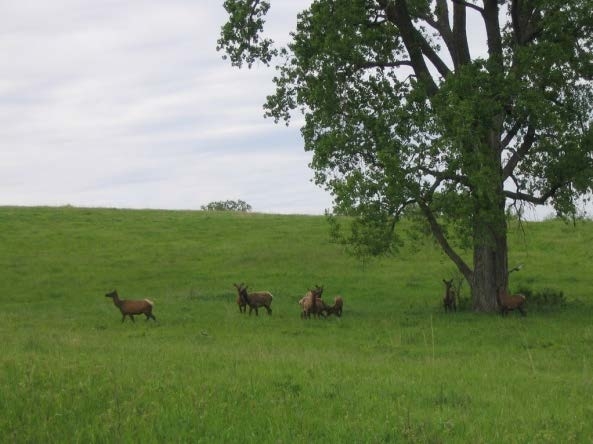NIFA Conservation Effects Assessment Project (CEAP)
Watershed Assessment Studies
Lessons Learned from the National Institute of Food and Agriculture (NIFA)-CEAP Synthesis Fact Sheet 2
Thirteen agricultural watershed projects were funded jointly by the USDA National Institute of Food and Agriculture (NIFA) and Natural Resources Conservation Service (NRCS) to evaluate the effects of cropland and pastureland conservation practices on spatial and temporal trends in water quality at the watershed scale. In some projects, participants also investigated how social and economic factors influence implementation and maintenance of practices. The 13 projects were conducted from 2004 to 2011 as part of the overall Conservation Effects Assessment Project (CEAP). The NIFA-CEAP projects were mainly retrospective; most conservation practices and water quality monitoring efforts were implemented through programs that occurred before the NIFA-CEAP projects began. By synthesizing the results of all these NIFA-CEAP projects, we explore lessons learned about the selection, timing, location, and relationships among conservation practices relative to how well they protect water quality.
In most of the NIFA-CEAP watersheds, conservation practices had been implemented through ongoing NRCS programs such as the Environmental Quality Incentives Program (EQUIP), or special projects such as the USDA Hydrologic Unit Area (HUA) program. The U.S. Environmental Protection Agency (EPA) Section 319 funds added to USDA funding in several watersheds. A few NIFA-CEAP projects benefited from the experience of local Agricultural Research Service (ARS) field research or other past efforts. Two NIFA-CEAP projects were in watersheds that served as the drinking water sources for urban areas (New York City, NY, and Wichita, KS). In both cases, the cities actively funded agricultural conservation programs to protect source water quality.
Conservation Practice Implementation and Maintenance
The following examples of NIFA-CEAP project results illustrate some important lessons learned about selecting and maintaining conservation practices.
The primary pollutants of concern in two watersheds were herbicides and nutrients. However, the implemented conservation practices (grassed waterways, terraces, or conservation tillage) were designed to control erosion. These projects were not able to show reductions in the primary pollutants of concern because the conservation practices used did not treat the pollutant. Although controlling erosion might have a subtle effect on pollutant reduction, the erosion control practices were not designed to control the primary pollutants.
Lesson: Identify the pollutant(s) of concern before attempting to select the conservation practice(s) that will be used for pollution control.
Several NIFA-CEAP projects identified stream bank erosion or historical sediments as the major source of sediment after land treatment efforts had prioritized upland erosion. As a result, little if any of the conservation implementation occurred where it was most needed.
Lesson: Indentify pollutant sources accurately because the best conservation practices will not work if they do not treat the problem.
Retrospective analyses of critical areas and conservation practice adoption in the Cheney Lake (KS), Goodwater Creek (MO), and Little Bear River (UT) watershed NIFA-CEAP projects confirmed that previously implemented conservation practices were not well prioritized. Results showed that 25% or fewer of the practices were implemented on the most important critical source areas in the watershed. Placement of practices was largely determined by the voluntary nature of most conservation programs. Ultimately, the lack of focus on critical source areas reduced the performance of conservation practices and the program’s cost-effectiveness.
Lesson: Identify and prioritize practice implementation to critical source areas. Where possible, modeling informed by local individuals and organizations with detailed knowledge of the watershed should be used to locate critical areas during project planning. This significant change to conservation programs must occur if federal and state human and financial resources are to be applied most effectively.
Terraces and grassed waterways were shown to reduce sediment losses in Cheney Lake (KS), Goodwater Creek (MO), and an Iowa watershed, but nitrate losses increased in two locations: Iowa and Missouri because of inlet drains in the terraces. A system of conservation practices (livestock exclusion fencing, stream bank crossings, and stream bank armoring) installed in the Spring Creek watershed (PA) reduced total suspended solids and fine sediments, leading to macroinverte-brate habitat improvement. No change occurred, however, in nutrient losses. In the Rock Creek watershed (OH), conservation tillage reduced total phosphorus losses but was believed to be partially responsible for increases in dissolved phosphorus concentrations in runoff. Almost total adoption of no-till changed the timing (fall rather than spring) and placement (surface rather than incorporated) of phosphorus fertilizers. In addition, there was dramatic increase in the acreage of tile drained lands. Although soil drainage has increased crop yields and the time farmers can work fields, it also has increased the land area (critical source area) contributing phosphorus to streams.
Lesson: Some conservation practices may have unintended consequences because of negative or contradictory effects on different pollutants. Efforts must be made to predict such outcomes so that tradeoffs can be considered in advance and activities modified to reduce adverse impacts.
The Little Bear River (UT) NIFA-CEAP project team assessed implementation and maintenance of previously installed conservation practices. Survey results indicated that 75% of management practices, 13% of planting practices, and 4% of structural practices were not fully implemented. In addition, 61% of management practices, 4% of planting practices, and 35% of structural practices had been discontinued or not maintained since they were implemented. Management practices had lower rates of maintenance than did structural or planting practices. Surveys of the other NIFA-CEAP projects also suggested that management practices are more difficult to implement and maintain than structural practices.
Lesson: Practices based on management changes, such as nutrient management, were less likely to be sustained by farmers. Post-implementation education and technical support must be used to assist farmers with adaptive management to ensure sustained effectiveness of conservation practices. If voluntary water quality protection efforts are to be effective in the United States, then conservation practices must be properly implemented and maintained.
Controlling Sediment
Conservation practices implemented in the NIFA-CEAP watersheds through standard conservation programming (NRCS and Soil and Water Conservation Districts) mainly addressed erosion on agricultural lands. Conservation tillage, grassed waterways, and terraces were the most common conservation practices regardless of whether sediment, nutrients, herbicides, or pathogens were the pollutants of concern.
Documented sediment load reductions occurred in Paradise Creek (ID) and Rock Creek (OH) watersheds due to aggressive implementation of conservation tillage in both watersheds and long-term (>20 years) water quality monitoring. In Ohio, farmers rapidly converted to conservation tillage once a trusted implement company introduced no-till planters. In Idaho, research and extension efforts directed at tillage and cropping systems, and federally funded practice support, effectively promoted the use of conservation tillage.
Lesson: Technology supported by research and extension outreach can effect changes in conservation and management. Acceptance of conservation tillage has been driven by two factors: Long-term government programs have supported conservation practices with research, extension, and funding. And technology changes (such as better seed drills and herbicides) have reduced production costs, including labor needs.
In two projects, it was observed that conservation tillage does not always reduce runoff or pollutant loss. Researchers in Kansas and Missouri found that runoff actually increased from claypan soils when conservation tillage was used. The Goodwater Creek (MO) project team found that losses of surface-applied chemicals, such as pesticides, increased under conservation tillage. Balancing reductions in erosion (conservation tillage practices) and controlling herbicide losses (soil incorporation of herbicides) was difficult. During the Cheney Lake (KS) project, experimental work demonstrated that terraces were much more effective at reducing ephemeral gully erosion than was conservation tillage. However, many terraces are being removed in this watershed as they interfere with modern large agricultural equipment.
Lesson: A conservation practice such as conservation tillage may have different environmental outcomes in different settings depending on factors such as the pollutant, soil type, or climate.
Controlling Nutrients
Nutrient, manure, and irrigation management were common approaches to nutrient load reduction. Riparian buffers to filter pollutants from runoff and livestock exclusion to reduce animal access to streams were implemented in several watersheds. An Iowa project converted extensive areas of cropland to native prairie and restricted fertilizer applications to remaining cropland.
Significant reductions in nutrient loads were demonstrated in three NIFA-CEAP watersheds. In New York and Iowa, the overall project design—including selection and implementation of conservation practices—was driven by programs outside normal USDA planning (U.S. Environmental Protection Agency 319 National Monitoring Program Project). A suite of conservation practices implemented on a dairy farm in the Cannonsville Reservoir watershed (NY) had a positive effect on water quality; particulate and soluble phosphorus and ammonium were greatly reduced. Multiple conservation practices were used, including nutrient management planning, crop rotation, strip cropping, riparian buffers, cattle exclusion, alternative water sources, and barnyard improvements. Based on water quality monitoring data and adaptive management, other conservation practices (precision feeding, an additional stream crossing, and stream bank restoration) were added to the farm.
A suite of conservation practices and land use change were also used in the Walnut Creek watershed (IA) to reduce nitrogen losses: large-scale conversion from soybeans and corn to tall grass prairie, combined with reduction of fertilizer inputs and drain plugging. Project results indicated that prairie restoration in this agricultural watershed reduced nitrate concentrations and loads but did not change phosphorus loads.
The only groundwater NIFA-CEAP project was located in the Central Platte region of Nebraska as part of an extensive 30-year effort to reduce groundwater nitrate via nutrient and water management. Quasi-regulatory programs were in effect in this watershed, which included farmer attendance at educational programs and annual reporting of irrigation use and quality. From 1987 to 2003, nitrate concentrations decreased by 18% but were still more than two times greater than the drinking water standard.
Lessons: Nutrient reductions will require selection and use of conservation practices that manage nutrients—not just sediment—and will also require significant adoption throughout the watershed. In watersheds with significant drainage, hydrologic modifications to change the loss pathway may be necessary. Even after conservation practices, including potential hydrologic modification, have been implemented, it will take a long-time for historic nutrients to be moved out of the system.
Riparian buffers were found to be effective in reducing total P loading in the Cannonsville Reservoir watershed (NY) by keeping pollutants (e.g., animal waste) out of the stream corridor rather than acting as a filter. In the Little River watershed (GA), natural buffers along most streams provide significant reduction of nutrients. Implementing buffers on productive land, however, was much more difficult in many of the watersheds because farmers were reluctant to take land out of production. In fact, buffers were the most unpopular practice in most project areas.
Lesson: Some practices may require unique or enhanced incentive packages to promote adoption, especially when economic disincentives exist.
Farmers most often adopted conservation practices because they recognized local problems such as erosion and they knew about the field-scale benefits of the practices. These factors made nutrient management the second most-disliked practice among the NIFA-CEAP projects. Farmers did not perceive a benefit from nutrient management in addressing local problems, and they lacked confidence in its on-farm benefits.
Lesson: Farmers have less interest in controlling pollutants, such as nutrients, that have downstream consequences than in controlling sediment with practices such as conservation tillage.
Lesson: The control of nonpoint sources of agriculturally derived nutrients will be a major challenge because (1) management practices, which are less likely to be sustained, are more effective than structural practices; (2) many conservation practices designed to control nutrients are disliked (nutrient management and buffers); and (3) farmers cannot readily observe nutrient losses whereas they can observe soil losses.
The Human Dimension
Conservation practices are implemented and maintained by farmers and ranchers. Although some factors in decisions to adopt a practice have been mentioned here, the decisions involved are complex and multidimensional. Reasons for or against adoption are highly variable and influenced by many factors. These factors are explored in detail in another fact sheet: “Lessons Learned in the NIFA-CEAP: How Farmers and Ranchers Make Decisions on Conservation Practices” (NIFACEAP Synthesis Fact Sheet 3).
Related Resources
Devlin, D. and L. French. 2011. Cheney Lake Watershed: Local Leadership: Goals and Actions. Kansas State University Agricultural Experiment Station and Cooperative Extension Service, Publication MF3032. Manhattan, KS.
Douglas-Mankin, K., P. Daggupati, A.Y. Sheshukov, P. Barnes, D. Devlin, and N. Nelson. 2011. Cheney Lake Watershed: Erosion from Ephemeral Gullies. Kansas State University Agricultural Experiment Station and Cooperative Extension Service, Publication MF3030. Manhattan, KS.
Line, D. E. and J. Spooner. 1995. Critical Areas in Agricultural Nonpoint Source Pollution Control Projects: The Rural Clean Water Program Experience. Raleigh: NC State University Water Quality Group.
Nelson, N., A. Bontrager, K. Douglas-Mankin, D. Devlin, P. Barnes, and L. Frees. 2011. Cheney Lake Watershed: Prioritization of Conservation Practice Implementation. Kansas State University Agricultural Experiment Station and Cooperative Extension Service, Publication MF3031. Manhattan, KS.
Osmond, D., D. Meals, D. Hoag, and M. Arabi (eds). 2012. How to Build Better Agricultural Conservation Programs to Protect Water Quality: The National Institute of Food and Agriculture Conservation Effects Assessment Project Experience. Ankeny, IA: Soil and Water Conservation Society.
Osmond, D. L., J. Spooner, and D. E. Line. 1995. Systems of Best Management Practices for Controlling Agricultural Nonpoint Source Pollution: The Rural Clean Water Program Experience. Raleigh: NC State University Water Quality Group.
Information
For more information about the NIFA-CEAP Synthesis, contact Deanna Osmond, NC State University.
Citation
Osmond, D. L., D. W. Meals, A. N. Sharpley, M. L. McFarland, and D. E. Line. 2012. Lessons Learned from the NIFA-CEAP: Conservation Practice Implementation and Adoption to Protect Water Quality. NC State University, Raleigh, NC.
Publication date: Jan. 1, 2012
Revised: Dec. 18, 2023
N.C. Cooperative Extension prohibits discrimination and harassment regardless of age, color, disability, family and marital status, gender identity, national origin, political beliefs, race, religion, sex (including pregnancy), sexual orientation and veteran status.






